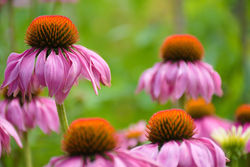Seed collection and winter sowing for Geum (Geum spp.): A step-by-step guide
- Lars Wildes

- Jul 4, 2024
- 3 min read
Geum, also known as Avens, is a delightful perennial that brings a burst of color to gardens with its bright and cheerful flowers. Known for their hardiness and ease of cultivation,
Geum plants are a fantastic addition to any garden. In this guide, we'll walk you through the process of collecting seeds from Geum and winter sowing them to ensure a vibrant bloom in your garden next spring.
Geum plants are versatile and thrive in well-drained soils. They are adaptable to various soil types, including sandy and clay soils, and prefer a sunny spot but can also do well in partial shade. Geums are drought-tolerant once established and grow best in slightly acidic to neutral soils.
Height: Generally grows between 12-24 inches (30-60 cm).
Flowers: Showy flowers in shades of red, orange, and yellow with a nodding form.
Bloom Time: Late spring to early summer, with some varieties blooming again in late summer.
Hardiness Zones: USDA zones 4-9.
Seed collection from Geum
The ideal time to collect Geum seeds is in late summer to early fall, after the flowers have faded and the seed heads have dried out.
What You Need
Sharp scissors or pruners
Paper bags or envelopes
Labels and a pen
Locate Seed Heads: Identify the dried seed heads on your Geum plants. They should be brown and brittle.
Harvest Seed Heads: Using scissors or pruners, carefully cut the seed heads from the plant to avoid losing seeds.
Store the Seed Heads: Place the seed heads in a paper bag or envelope and label them with the plant name and the date of collection.
Drying: Allow the seed heads to dry completely in a cool, dry place for a few days to ensure the seeds are fully mature.
Extract the Seeds: Once dry, gently crush the seed heads to release the seeds. Separate the seeds from the chaff using a sieve or by blowing gently.
Store the Seeds: Keep the seeds in a labeled envelope in a cool, dark place until you're ready to sow.
Geum winter sowing
Winter sowing mimics natural germination processes and is an excellent method for starting perennial seeds like Geum.
Here are a few different ways to winter sow plus our favorite method:
What You Need
Clear plastic containers with lids (e.g., milk jugs, large yogurt containers)
Potting soil or seed starting mix
A drill or knife (for making drainage holes)
Duct tape
Labels and a pen
Step-by-Step Process
Prepare Your Containers: Clean the plastic containers and cut them around the middle, leaving a small hinge for easy opening and closing. Make drainage holes in the bottom using a drill or knife.
Fill with Soil: Add about 3-4 inches of potting soil or seed starting mix to the bottom half of the container. Moisten the soil until it is damp but not soaked.
Sow the Seeds: Sprinkle the Geum seeds on the surface of the soil. Lightly press them into the soil without covering them, as they need light to germinate.
Seal the Containers: Close the containers and secure them with duct tape. Label each container with the plant name and the date of sowing.
Place Outside: Set the containers outside in an area exposed to winter weather but protected from strong winds. The seeds will undergo natural stratification, with the freezing and thawing cycles promoting germination.
Monitor the Seeds: Check the containers occasionally throughout the winter to ensure they have enough moisture. In early spring, watch for signs of germination.
By following these steps, you can successfully collect seeds and winter sow Geum, ensuring a lush and colorful display in your garden. This method is not only cost-effective but also deeply rewarding as you watch your garden grow from seeds you’ve collected yourself. Happy gardening!
We’d love to hear about your experiences with Geum or any tips you might have. Feel free to share your thoughts in the YouTube video and connect with other gardening enthusiasts.













Comments